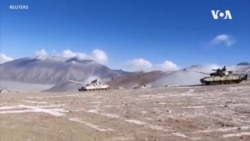ກຳລັງທະຫານ ອິນເດຍ ແລະ ຈີນ ໄດ້ຖອນຕົວອອກຈາກເຂດຊາຍແດນທີ່ມີການຂັດແຍ້ງກັນ ທີ່ໄດ້ກໍ່ໃຫ້ເກີດການປະເຊີນໜ້າກັນດົນ 9 ເດືອນ ລະຫວ່າງສອງປະເທດທີ່ວ່ານັ້ນ ແຕ່ການຟື້ນຟູສາຍພົວພັນຈະບໍ່ເປັນເລື່ອງທີ່ງ່າຍໃນຂະນະທີ່ຄວາມຂັດແຍ້ງຍັງຄົງມີຢູ່. ແນວໃດກໍຕາມ, ສາຍພົວພັນດ້ານການຄ້າລະຫວ່າງສອງປະເທດທີ່ມີເສດຖະກິດໃຫຍ່ໃນເອເຊຍນັ້ນແມ່ນຄາດວ່າຈະດີຂຶ້ນ. ນັກຂ່າວວີໂອເອ ອາຈະນາ ປາຣິສຈາ (Anjana Parischa) ມີລາຍງານ ເຊິ່ງ ພຸດທະສອນ ຈະນຳລາຍລະອຽດມາສະເໜີທ່ານໃນອັນດັບຕໍ່ໄປ.
ປືນໃຫຍ່ ແລະ ລົດຖັງຂອງ ຈີນ ແລະ ອິນເດຍ ໄດ້ຖອຍກັບ ແລະ ທະຫານ ກໍໄດ້ຖອນຕົວອອກຈາກແຄມຝັ່ງຂອງທະເລສາບຍຸດທະສາດ ປາງກອງ ເຊິ່ງ ໄດ້ເຊື່ອມຕໍ່ເຂດຊາຍແດນຂອງເຂົາເຈົ້າໃນພູຫິມາໄລ.
ໃນວິດີໂອທີ່ຖືກເປີດເຜີຍ ກ່ຽວກັບ ການຖອນກຳລັງນັ້ນ, ກອງທັບບົກ ອິນເດຍ ໄດ້ກ່າວວ່າສິ່ງປູກສ້າງຊົ່ວຄາວທີ່ຖືກຕັ້ງຂຶ້ນໂດຍ ຈີນ ແມ່ນໄດ້ຖືກຮື້ອອກ.
ການຖອນຕົວຫຼັງຈາກການປະເຊີນໜ້າກັນ 9 ເດືອນຈາກຈຸດທີ່ມີບັນຫາທີ່ສຸດໃນພາກພື້ນລາດັກ ຂອງ ອິນເດຍ ແມ່ນສຳຄັນຫຼາຍ. ແຕ່ມັນເປັນພຽງການເລີ່ມຕົ້ນເທົ່ານັ້ນ.
ທ່ານ ຈາຢາເດວາ ຣາເນດ, ຈາກສູນກາງການວິເຄາະ ແລະ ແຜນຍຸດທະສາດ ຈີນ ກ່າວວ່າ “ມັນແມ່ນບາດກ້າວທຳອິດ, ບາດກ້າວທົດລອງ. ແຕ່ແມ່ນແລ້ວ, ມັນໄດ້ແນເປົ້າໃສ່ການຜ່ອນຄາຍຄວາມເຄັ່ງຕຶງ ເຊິ່ງມີຢູ່ໂດຍສະເພາະໃນຈຸດນີ້ຢູ່ອ້ອມທະເລສາບ ປາງກອງ.”
ລັດຖະມົນຕີປ້ອງກັນປະເທດ ອິນເດຍ ທ່ານ ຣານາດ ຊິງ ໄດ້ກ່າວຕໍ່ສະພາແຫ່ງຊາດໃນເດືອນນີ້ວ່າ ຄວາມຂັດແຍ້ງຍັງຄົງມີຢູ່ຕາມເຂດຊາຍແດນທີ່ຮູ້ຈັກກັນໃນຊື່ ເສັ້ນການຄວບຄຸມທີ່ແທ້ຈິງ ຫຼື LAC.
ທ່ານ ຣານາດ ຊິງ ກ່າວວ່າ “ມັນຍັງມີບັນຫາທີ່ໂດດເດັ່ນຢູ່ ກ່ຽວກັບ ການສົ່ງທະຫານ ແລະ ການລາດຕະເວນຢູ່ເສັ້ນການຄວບຄຸມທີ່ແທ້ຈິງນັ້ນ. ພວກເຮົາຈະເພັ່ງເລັງໃສ່ບັນຫານີ້ໃນການປຶກສາຫາລືຂ້າງໜ້າ.”
ການເຈລະຈາໄດ້ເລີ່ມຂຶ້ນ ກ່ຽວກັບ ການຖອນອອກຈາກຈຸດທີ່ມີບັນຫາອີກສາມບ່ອນຢູ່ຕາມເຂດຊາຍແດນໃນພາກພື້ນ ລາດັກ. ແຕ່ຄວາມເຄັ່ງຕຶງໃນພູຫິມາໄລ ແມ່ນມີຄວາມເປັນໄປໄດ້ວ່າຈະເບົາລົງທ່າມກາງຄວາມສົງໄສທີ່ເພີ່ມຂຶ້ນໃນ ອິນເດຍ, ເຊິ່ງ ໄດ້ກ່າວຫາ ຈີນ ກ່ຽວກັບ ການຈູ່ໂຈມເຂດຊາຍແດນ.
ທ່ານ ຈາຢາເດວາ ຣາເນດ ກ່າວວ່າ “ຈຸດສຳຄັນກໍແມ່ນ ຈີນ ໄດ້ຫວັງຫຍັງ ເພື່ອບັນລຸຄວາມສຳເລັດດ້ວຍການກະທຳຂອງເຂົາເຈົ້າ, ເຈຕະນາຂອງເຂົາເຈົ້າແມ່ນຫຍັງ? ແນ່ນອນ, ນັ້ນຈະເປັນເລື່ອງທີ່ຢູ່ໃນຄວາມຄິດຂອງບັນດາຜູ້ວາງແຜນ ອິນເດຍ ແລະ ຈະຮັບປະກັນວ່າພວກເຮົາຈະລະມັດລະວັງໃນອະນາຄົດ, ລະມັດລະວັງຫຼາຍຂຶ້ນສຳລັບການກະທຳຂອງ ຈີນ.”
ການຟື້ນຟູສາຍພົວພັນອາດຈະງ່າຍກວ່າ. ອິນເດຍ ໄດ້ຫ້າມການໃຊ້ແອັບພລີ ເຄຊັ້ນ Tik Tok ຂອງ ຈີນ ແລະ ໄດ້ຂະຫຍາຍອຸປະສັກຕໍ່ການລົງທຶນ ຈີນ ໃນເວລາທີ່ຄວາມເຄັ່ງຕຶງທາງທະຫານໄດ້ຮຸນແຮງຂຶ້ນໃນປີກາຍນນີ້. ມັນມີການຮຽກຮ້ອງຫຼາຍກວ່າເກົ່າເພື່ອຫ້າມສິນຄ້າ ຈີນ ທ່າມກາງຄວາມຄິດຊາດນິຍົມທີ່ເພີ່ມຂຶ້ນ.
ແຕ່ສິນຄ້າ ຈີນ, ຈາກເຄື່ອງປະດັບລາຄາຖືກຫາໂທລະສັບມືຖືນັ້ນ, ໄດ້ສືບຕໍ່ຫຼັ່ງໄຫຼເຂົ້າຕະຫຼາດ ອິນເດຍ. ອຸດສາຫະກຳຂອງ ອິນເດຍ ຫຼາຍຂະແໜງເຊັ່ນ ເພສັດສະກຳ ແລະ ພະລັງງານແສງຕາ ເວັນ ແມ່ນຍັງຄົງອາໄສຊິ້ນສ່ວນຈາກ ຈີນ ຢູ່. ການສົ່ງອອກຂອງ ອິນເດຍ ໄປ ຈີນກໍໄດ້ຂະຫຍາຍຕົວໃນປີກາຍນີ້.
ທ່ານ ບິສວາຈິດ ດາ, ອາຈານສອນເສດຖະສາດ ຢູ່ມະຫາວິທະຍາໄລ ຈາວາຮາລາລ ເນຣູ ໄດ້ກ່າວວ່າ “ອຸດສາຫະກຳ ອິນເດຍ ຕອນນີ້ແມ່ກຳລັງເບິ່ງ ຈີນ ວ່າເປັນຕະຫຼາດ ແລະ ຈີນ ກໍໄດ້ສະເໜີຕະ ຫຼາດດັ່ງກ່າວໃຫ້ ອິນເດຍ. ສະນັ້ນ, ການຜັກດັນແມ່ນຈະເປັນສອງທາງ. ກ່ອນໜ້ານີ້ການຜັກດັນແມ່ນພຽງຈາກພາກສ່ວນຕ່າງໆ ຊຶ່ງມີແຕ່ອາໄສການນຳເຂົ້າຈາກ ຈີນ. ແຕ່ຕອນນີ້ ມັນພາກສ່ວນ ຕ່າງໆຄື ເຫຼັກ ແລະ ອື່ນໆທີ່ອາໄສຕະຫຼາດໃນ ຈີນ. ສະນັ້ນ, ມັນຈະມີກຸ່ມ ທີ່ຂ້ອນຂ້າງໃຫຍ່ໃນ ອິນເດຍ ເຊິ່ງຈະຊອກຫາທາງຟື້ນຟູສາຍພົວພັນກັບຈີນ.”
ນັ້ນກໍໝາຍຄວາມວ່າ ສາຍພົວພັນທາງການເມືອງ ແລະ ເສດຖະກິດລະຫວ່າງ ສອງປະເທດ ທີ່ໃຫຍ່ທີ່ສຸດໃນ ເອເຊຍ ນັ້ນ ອາດເຄື່ອນໄປໃນເສັ້ນທາງທີ່ແຕກຕ່າງກັນ.
Indian and Chinese troops have withdrawn from a disputed border that triggered a nine-month long standoff between the two countries but rebuilding ties will not be easy as disputes linger. However, trade ties between the two large Asian economies are expected to improve. Anjana Pasricha has a report.
Chinese and Indian artillery and tanks have rolled back, and soldiers have retreated from the banks of the strategic Pangong lake which straddles their border in the Himalayas.
In video released on the pullback, the Indian army said temporary structures erected by the Chinese have been dismantled.
The disengagement after a nine-month standoff from the most fractious point in India’s Ladakh region is significant. But it is only a start.
“It’s a first step, a tentative step. But yes, it is aimed at defusing the tension which exists particularly at this point around Pangong.”
Indian Defense Minister Rajnath Singh told parliament earlier this month that disputes persist along the border known as the line of actual control or LAC.
“There are still some outstanding issues with regard to deployment and patrolling at the LAC. We will focus on these in further discussions.”
Talks have started on stepping back from three other friction points along the border in Ladakh. But tensions in the Himalayas are likely to simmer amid growing suspicion in India, which has accused China of border incursions.
“The main point is what did the Chinese hope to achieve by their action, what was their intention? Certainly, those will be factors in the minds of the Indian planners and will ensure that we will be vigilant in future, more vigilant in future for Chinese actions.”
Restoring economic ties may be easier. India banned Chinese apps such as Tik Tok and raised barriers to Chinese investment as military tensions spiked last year. There were growing calls to boycott Chinese goods amid increasing nationalist sentiment.
But Chinese goods, from low-cost accessories to mobile phones, continue to flood Indian markets. Many Indian industries such as pharmaceuticals and solar power remain dependent on Chinese components. Indian exports to China grew last year.
“Indian industry is now looking at China as a market and China has offered India the market. So, the push is going to be both ways. Earlier the push was only from the sectors which there were dependent on imports from China. Now there are sectors like steel and others who are dependent on markets in China. So, there is going to be a substantially large constituency in India which will be seeking normalization of relations with China.”
That means political and economic ties between Asia’s two biggest countries could move on divergent paths.





